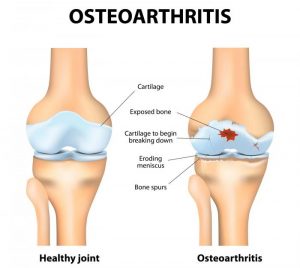According to Arthritis Australia (2017), there are about 3.9 million Australians who are affected by arthritis, which means 1 in 6 of us. Arthritis can be managed either through surgery or conservatively, meaning no surgery is required. This is possible because while the joint damage can’t be reversed, research has shown that other factors such as strength, fitness, weight loss, flexibility and education can all dramatically improve someone’s pain and function. And not only that but this can be as or more effective than surgery.
What is arthritis?
‘Arthritis’ is a term used for a group of conditions that affect the joints of the body leading to pain and stiffness in the joints. Affected joints become swollen and painful, and when we look at the joint surfaces we can see damage in the form of roughness of the normally smooth lining of the bone called cartilage.

One of the most common joints that OA affects is the knee. There has been a lot of research over recent years showing that conservative management with a physiotherapist has better short and long term outcomes than key hole surgery. According to Zhang et al (2008) OA patients should be encouraged to undergo regular aerobic, muscle strengthening and range of motion exercises. Much of the research that has been done has shown that physiotherapy helped the patient to a higher degree in the short term (Huang et al 2005, Hughes et al 2006). Other research has provided evidence for a long term positive effect with constant monitoring (Huang et al 2005).
People with knee arthritis generally want to avoid surgery and prefer to follow conservative management. Conservative management requires a physiotherapist to provide an exercise plan to better manage the OA in the knee. Optimal exercise programs should be specific to the person and include aerobic capacity, quadriceps muscle strength, stretches and optimizing lower limb performance. Exercise therapy and manual mobilization done by a physiotherapist have been shown to provide the most benefit (Deyle et al 2005).
What if I still need surgery?
In the most advanced cases a joint replacement is required when the pain in the knee is severely limiting the persons quality of life. In such cases the role of exercise before surgery to maximize mobility and strength is not to be underestimated as it generally leads to better recovery after surgery. And after surgery patients will always be referred to physiotherapy for rehabilitation to regain lost strength and mobility.
So regardless of whether a knee is in the early stages of OA or in the more advanced stages and needing joint replacement, it always pays to have a specific exercise program tailored to your needs and goals. Remember, maintaining quality of life and function in your knee is always about more than only surgery. If you haven’t had a physiotherapist assess you and your knee function individually you may well be missing out on the best quality of life, and what is that worth to you? Priceless!
